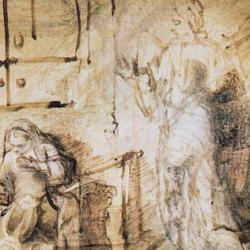Opening Heaven’s Floodgates, edited by Jason Silverman, is a wide-ranging collection of essays about the “Genesis flood narrative, its context, and reception.”
The book includes detailed essays on the differing chronologies of the flood narrative in various ancient versions; comparative studies of Mesopotamian and Iranian myths; the use of the flood narrative in Jewish apocalyptic literature; the reception of the flood story in popular ark replicas, in nineteenth-century music, and in apocalyptic film; and the implications of the flood narrative for our understanding of the image of God and environmental ethics.
The essays assume that the Genesis flood narrative is myth, which Silverman defines as “an attempt to understand and impart meaning to reality in narrative and symbolic form without regard to empiricist concerns.” Myth is defined by function – “the teller is not concerned with the evidence per se but with how it explains and imparts meaning to reality” – as it raises and attempts to answer the big questions about the world (5-6, 8). The writers take the text seriously, and recognize relationships between the Genesis account and other ancient flood stories. None take the narrative as history in any of the usual senses of the word.
For my purposes, the two most interesting essays were Elizabeth Harper’s close literary reading of the flood story and Murray Watson’s analysis of Andre Chouraqui’s translation of the text.
Harper asks more questions than she answers as she follows the twists and turns of the narrative as it is overshadowed by Lamech’s hope that his son would bring “comfort” from the “ground which Yahweh cursed” (Genesis 5:29). She notes a tension between Noah’s actual name (noach, “rest”) and Lamech’s statement (hope for comfort, nacham), noting accurately that in the Bible “comfort” “changes things” rather than merely soothing suffering (35).
Harper follows a cascade of wordplays coming from that opening verse. Noah finds favor (chen) in the eyes of Yahweh, and the word for “favor” is “a palindrome of Noah” (38-39). Genesis 5:32 begins with the three letters of the word “comfort”; Noah found favor begins, in Hebrew, as nchm. Things take a discouraging twist as chapter 6 opens to disclose a world filled with violence (chamas) a word that echoes the name of one of Noah’s sons, cham, who will later do some violence to Noah. The names Noah and Ham together form nacham, but the reference to comfort is still “equivocal.” She finds wordplay in the instructions for the ark, which is to be made of gopher wood, a term that rhymes with kopher, “to cover,” which is what Noah is supposed to do to the ark. She disputes the translation of kopher as “pitch,” arguing that it refers instead to “a ‘ransom’ to redeem life” (40). At the end of the narrative, Noah finally makes good on his name, offering a sacrifice that produces a “restful” (nychch) scent that soothes Yahweh (49) and drinking wine that induces sleep. It seems, perhaps, that Lamech’s hope has been fulfilled, though Harper is still uncertain enough to pose the point as a question: “In washing the adamah of its corruption did the flood also purify this accursed status, or at least ameliorate the curse in some way?” (51).
La Bible Chouraqui, published in the 1970s, was a translation in the tradition of Buber, Rosenzweig, and more recently Everett Fox. (Derrida devoted at least one essay to Chouraqui’s Bible late in his life.) Andre Chouraqui, a polymathic Algerian-French-Israeli diplomat, attempted to defamiliarize the Bible by sticking with Hebrew idioms and syntax. He refuses the normal translation of teba’ by “arche,” choosing to call it a “caisse” (“a chest or rigid sort of box made from a solid material”). This is distinguished from his translation of the Mosaic ‘aron, which he renders as “coffre.” The translation choice makes it clear that there are different Hebrew terms behind “Noah’s ark” and “ark of the covenant” (351).
When the Hebrew doubles using a verb and object from the same root, Chouraqui doubles too: “asphalte-le . . . avec l’asphalte” (Genesis 6:14). He not only catches the link between the verb ‘alah and the offering, ‘olah, but translates in a way that captures the notion of ascent: “il fait monter dse montees sur l’autel” (8:20). Yahweh makes clouds cloud the earth, and Chouraqui translates, “quand je ferai nuer la nuee dur la terre” (9:14). Mountains do not have peaks covered but water; they have “tetes.” Watson raises some of the standard objections against this approach, but the effect of this mode of translation is just right: “his wordings often draw the unsuspecting reader up short, provoking puzzlement and (sometimes secondarily) appreciation and insight of the subtleties of Chouraqui’s word-choices” (357).
Many the other essays in Silverman’s substantial volume will also stimulate and delight, testimony to the skill of the contributors and, more fundamentally, to the cryptic, teasing depths of the flood narrative itself.















